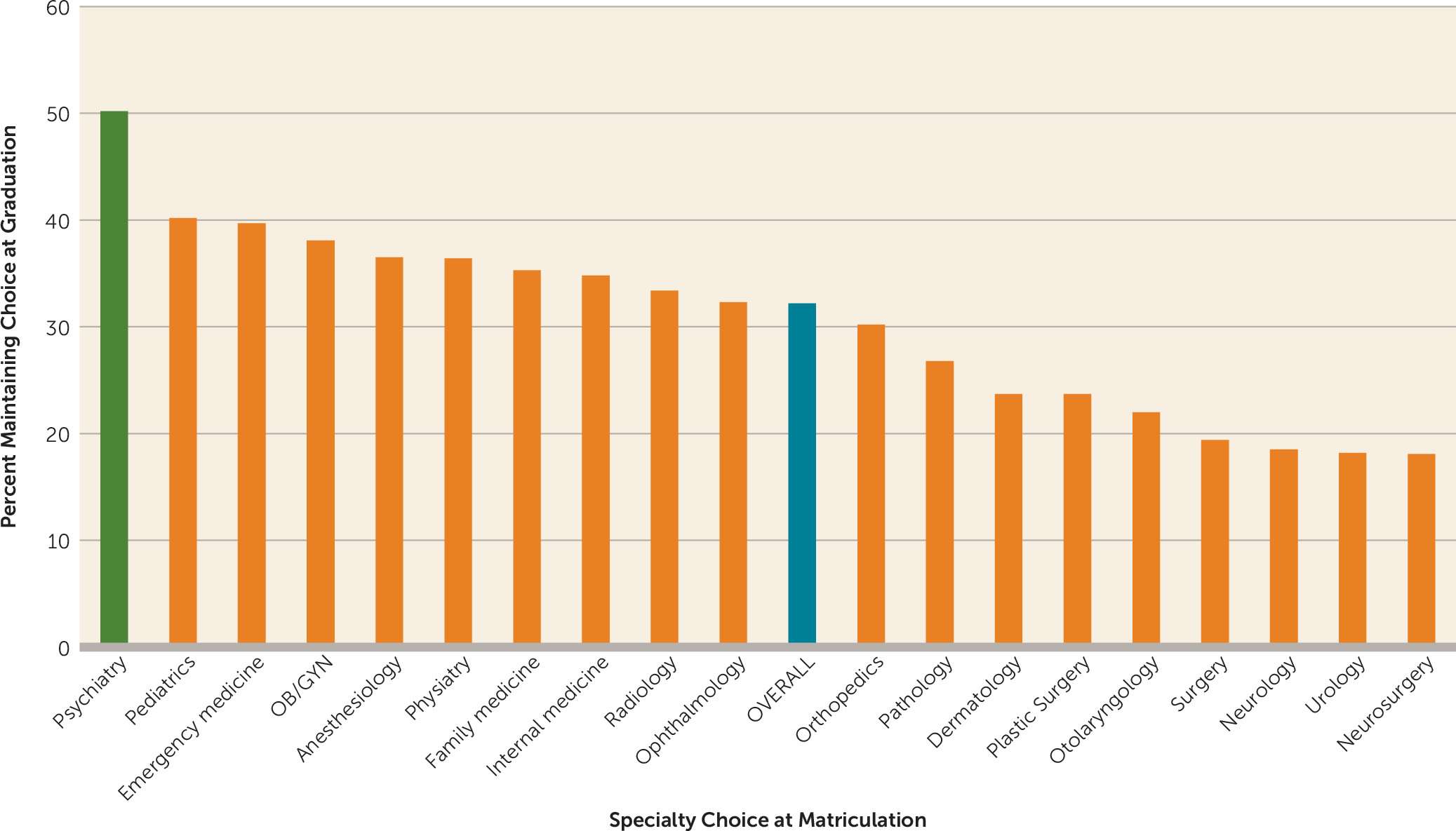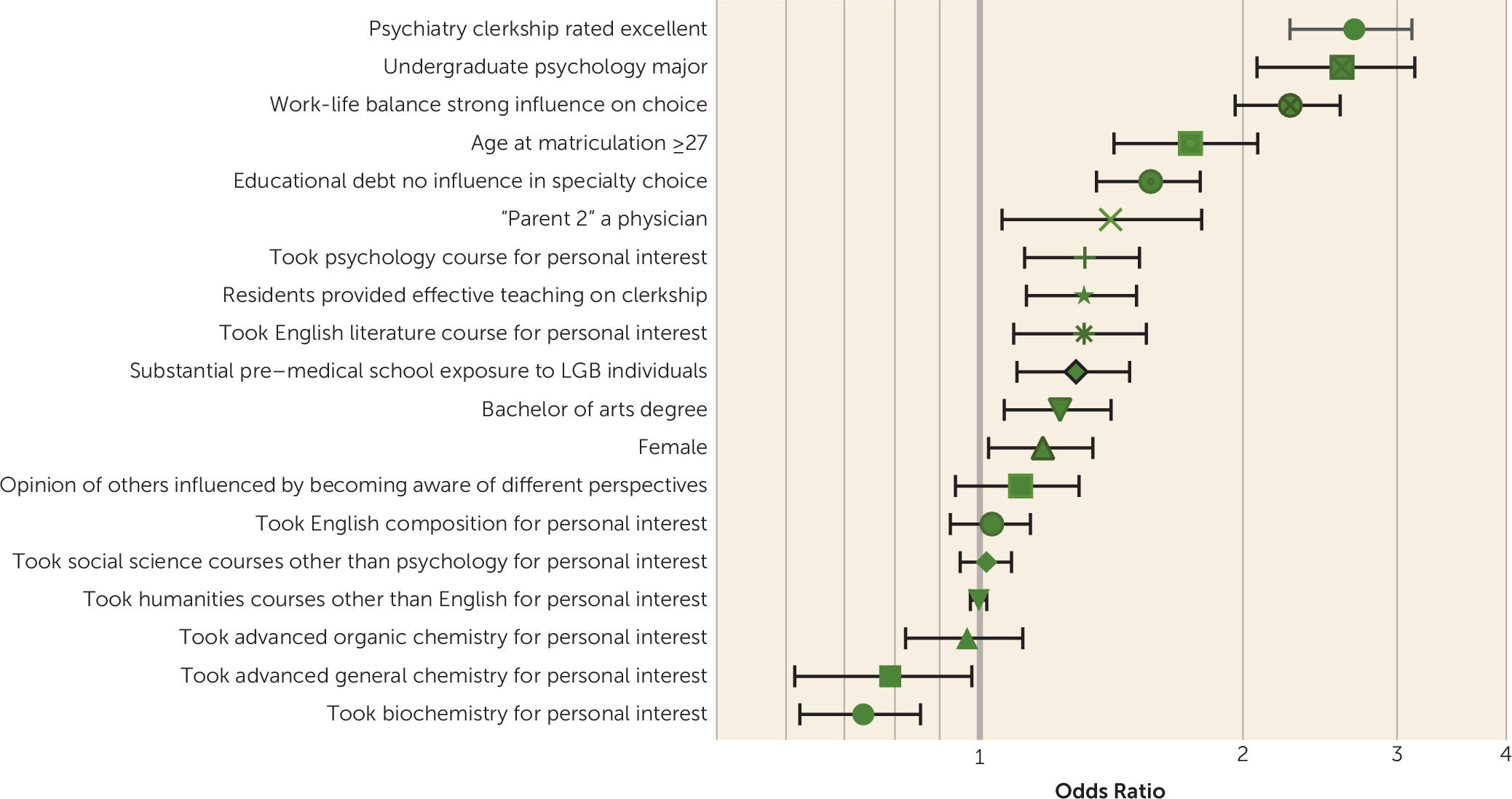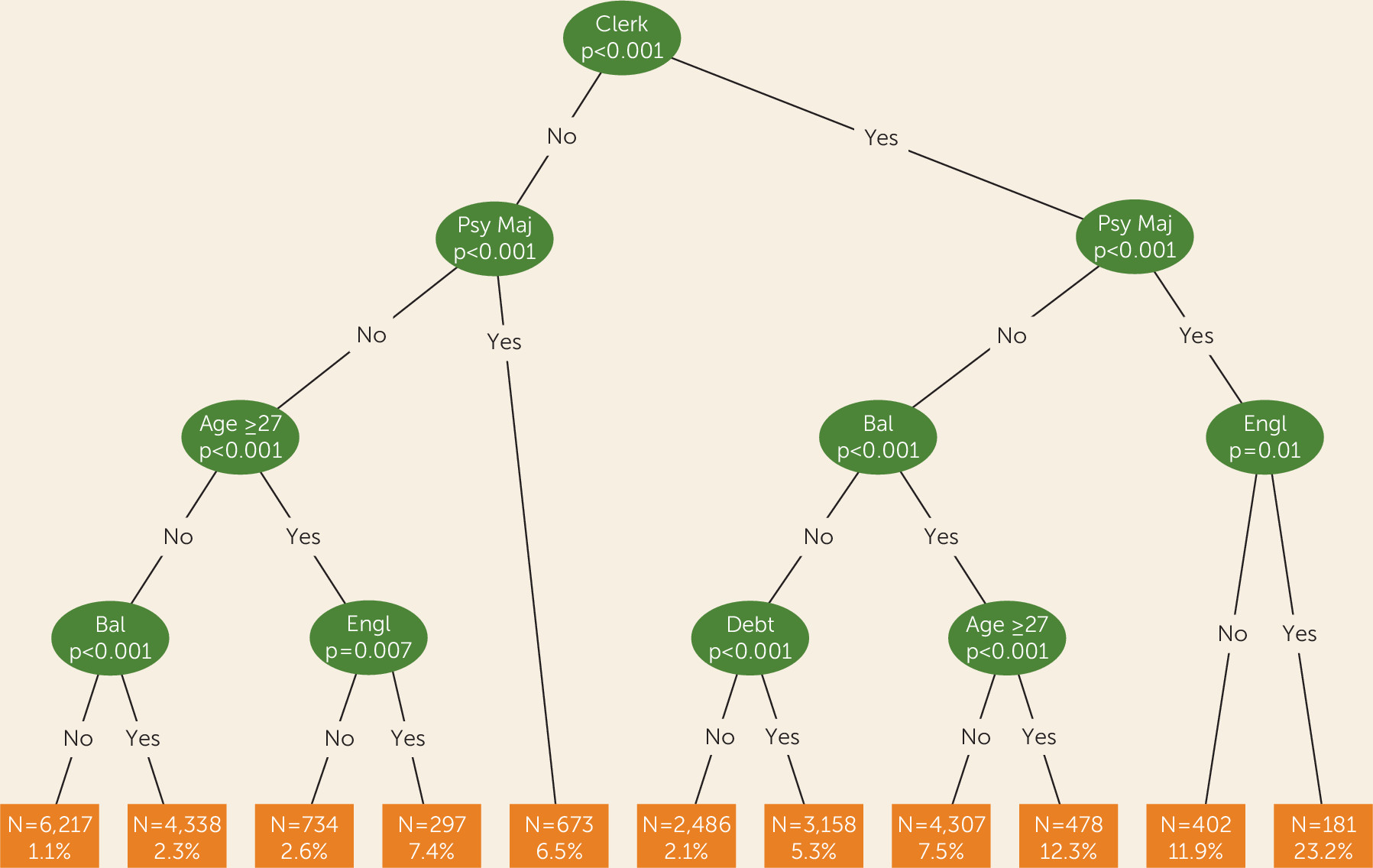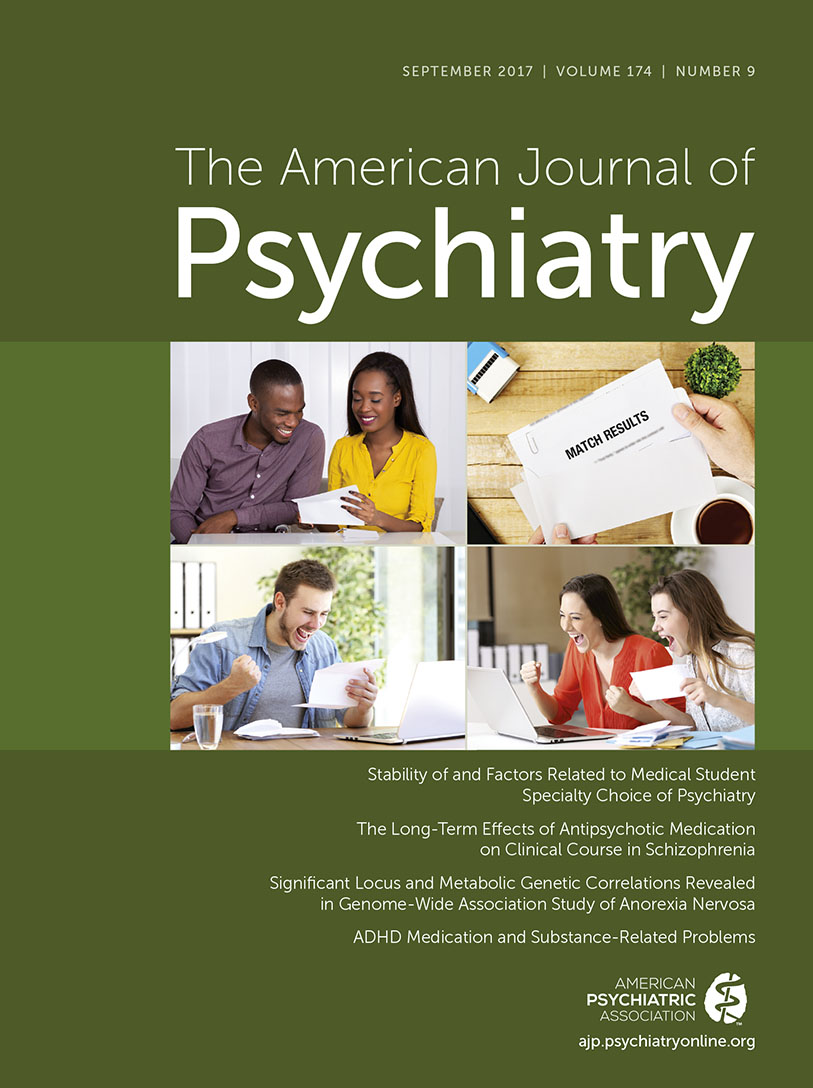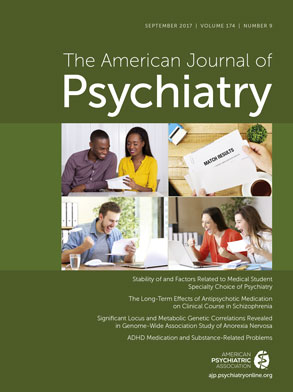There is a shortage of mental health specialists, including psychiatrists, in the U.S. health system (
1). After World War II, 7%−10% of medical school graduates entered psychiatry, but rates declined in the 1970s and have since ranged from 3.1% to 5.5% (
2). Over the past 4 years, the percentage of U.S. medical school seniors choosing psychiatry rose from 3.9% in the 2012 match to 4.2% in the 2013 and 2014 matches, to 4.6% in the 2015 match, and finally to 5.0% in the 2016 match (
3). Although psychiatry accounts for 5% of residency slots nationally, since 2011 only 50%−62% of these slots have been filled by graduates of allopathic U.S. medical schools (
2).
Recruitment of medical students into psychiatry has long been important to psychiatric educators and has increasingly become a priority of health policy makers as well (
1,
4). Understanding the timing and stability of and factors related to student career choice could aid in the development of recruitment and mentoring strategies to increase the number and quality of students choosing psychiatry (
5). One potential strategy could be to attract to medical school those students who are more likely to choose psychiatry and/or those who have a particular aptitude for the field. An alternative approach could be to target recruiting efforts toward already-matriculated medical students, particularly those who might be most amenable to changing to psychiatry from other initial specialty interests.
A student’s specialty choice is multifactorial, a combination of student characteristics, values, and needs, medical school experience and curricula, and perceptions of specialties (
6). Several small studies have examined factors related to the choice of psychiatry as a specialty, including student-level factors (e.g., demographic factors, educational background, and experience) and school-level factors (
7). Relative to other students, those interested in psychiatry are more likely to have a personal or family experience with mental illness or to have an undergraduate major in a nonscience or humanities discipline (
8). Students who prefer psychiatry are also more likely to cite work-life balance and less likely to cite concern about debt or salary expectations as factors in their specialty choice (
9). Highly rated psychiatry clerkships have been shown to increase student interest in the field (
10). Students who attend medical schools that have more respected psychiatry departments and residents, less antipsychiatry attitudes among fellow students, and longer psychiatry clerkships are more likely to choose the specialty (
11).
Previous studies of specialty choice timing and stability have yielded varied results. A survey of students at 15 U.S. medical schools found that for most specialties, including psychiatry, only a quarter to a third of students maintained their initial specialty interest through graduation (
12). A more recent study of Canadian medical students suggested that about half of students in all disciplines were consistent in their specialty preference, with the highest stability found in family medicine (
13). Another study found that 45% of students correctly predicted their ultimate specialty choice at matriculation, and nearly 70% did before beginning their clinical clerkships (
14). None of these studies were sufficiently powered to determine whether students choosing psychiatry differed from other students in the timing or stability of their choice.
In order to generate a sufficiently large and representative sample of students choosing psychiatry, a national data set is required. The Association of American Medical Colleges (AAMC) conducts annual surveys of medical students at all allopathic medical schools at the beginning of medical school, from early June through mid-September, with the Matriculating Student Questionnaire (MSQ), and again at the end of medical school, from mid-February through early June, with the Medical School Graduation Questionnaire (GQ). Both surveys include an item on preferred specialty in addition to a variety of items related to pre- and intra–medical school experiences.
Method
We obtained AAMC survey data from all medical students who completed the GQ in 2013 and 2014 (N=29,713). AAMC data stewards matched this GQ data at the level of the individual student to responses on the MSQ and other pre–medical school data. Any potentially identifying information was removed from each record. The AAMC also restricted researcher access to certain fields (e.g., medical school, race/ethnicity) that could have, in combination with other fields, potentially been used to identify individual respondents. Institutional review boards at the authors’ institutions deemed the study to be exempt from full review.
We examined the responses to the MSQ and GQ items on specialty choice using the medical specialties listed on the surveys. The AAMC surveys asked students whether they planned to become certified in a specialty. Students who answered “yes” to this gateway question were then asked which specialty they planned to pursue but were not given the option of “undecided.” We calculated the overall prevalence of specialty choice of psychiatry and the other specialties at both beginning and end of medical school among all respondents who answered the specialty preference item on the MSQ (N=17,995) and the GQ (N=23,271) (
Table 1). We also computed the degree of change for each specialty during medical school. A chi-square test was used to compare the proportion of change in psychiatry specialty choice with that in other specialties.
Using individual-level survey data, we calculated the percentages of students who maintained their specialty choice (same specialty on MSQ as GQ) and those whose choices changed (different specialty on MSQ and GQ). We used a chi-square test to compare the stability of choice for students choosing psychiatry relative to those choosing a different specialty. We also identified specialties to and from which students switched from and to psychiatry.
Two authors (M.N.G., J.J.S.) reviewed the available AAMC survey items and, based on review of the literature, identified 29 student-level factors (some demographic, some experiential) that were hypothesized to be associated with psychiatry specialty choice (see Table S1 in data supplement that accompanies the online edition of this article). Survey items that were coded using a Likert scale were recoded as dichotomous, with the answers coded for either the strongest value or any other response (for example, “Rate the quality of your educational experiences in the following clinical clerkships” was recoded to indicate either “excellent” or “all other responses”).
The analytic approach was adapted from a study of cannabis abuse factors to predict at-risk users using logistic regression and recursive partitioning (
15). In order to determine which of the 29 variables would be included in the subsequent modeling, we analyzed all 29 variables using bivariate logistic regression, with the selection of either psychiatry or any other identified specialty on the specialty preference item on the GQ as the binary dependent variable (N=23,271). To account for multiple comparisons in the bivariate analysis step, we applied the Bonferroni correction, and alpha was set at 0.05/29 so that only variables with a p value <0.0017 were selected as variables for the multivariate logistic regression analysis.
The 20 variables identified in the bivariate analysis were then entered into a multivariate modeling procedure, and an iterative procedure was used to identify the 10 best goodness-of-fit logistic models using the Akaike information criterion for all students who had identified a specialty choice on the GQ, with the selection of either psychiatry or any other identified specialty as the binary dependent variable (N=23,271). Any variables that were identified in any of the top 10 logistic models were included in the final logistic regression and recursive partitioning. Recursive partitioning trees were constructed using a 95% family-wise Bonferroni correction criterion. The same analytic strategy was used to evaluate separately two subgroups of students: 1) those who identified psychiatry on the MSQ and either chose psychiatry or a different specialty on the GQ (N=235) and 2) those who chose a specialty other than psychiatry on the MSQ and either chose psychiatry or a different specialty on the GQ (N=14,287).
All analyses were performed using the R statistical environment, version 3.0.1. The recursive partitioning was performed using the “party” version 1.0-9 for R (
16,
17). The iterative best fit logistic models were performed using the glmulti R package [X1] (
18).
Results
Psychiatry specialty choice increased from 1.6% of students on the MSQ to 4.1% on the GQ (
Table 1), an increase of nearly 150% from matriculation to graduation. This rate was higher than all but one other specialty (urology) and significantly higher than the average of all specialties (i.e., no change, p<0.001) (
Figure 1).
Among students who chose psychiatry at matriculation, 50.2% maintained that choice at graduation (
Table 2). This stability rate was significantly higher than that for all students overall (32%, p<0.001) and significantly higher than for any other specialty (
Figure 2). Students who changed from psychiatry (49%) to another specialty during medical school chose a variety of other fields, with more than half choosing primary care specialties: internal medicine (22.2%), pediatrics (13.7%), family medicine (10.3%).
Nearly 80% of students who indicated the choice of psychiatry at graduation had indicated another specialty choice at matriculation. Students who changed to psychiatry from another specialty during medical school initially selected a variety of other fields, often neurology (8.4%) and primary care specialties: internal medicine (18.1%), pediatrics (14.8%), and family medicine (9.3%).
Among all students who identified a specialty choice on the GQ, in the logistic regression (
Figure 3) a student’s rating of the psychiatry clerkship as excellent was the factor most highly associated with psychiatry specialty choice (odds ratio=2.66) (all odds ratios are adjusted, with p<0.05; see the
online data supplement for all variables and confidence intervals). Other positively associated factors include an undergraduate psychology major (odds ratio=2.58), reporting work-life balance as a strong influence (odds ratio=2.25), being age 27 or older at matriculation (odds ratio=1.72), reporting educational debt as having no influence (odds ratio=1.56), listing “parent 2” a physician (odds ratio=1.38), having taken undergraduate psychology (odds ratio=1.31) and English literature (odds ratio=1.30) for personal interest, strongly agreeing that psychiatry residents provided effective teaching during the clerkship (odds ratio=1.31), having substantial pre–medical school interaction with lesbian, gay, or bisexual (LGB) individuals (odds ratio=1.28), having a bachelor of arts degree (as opposed to a bachelor of science degree) (odds ratio=1.23), and being female (odds ratio=1.17). Having taken undergraduate biochemistry (odds ratio=0.73) or advanced general chemistry (odds ratio=0.78) for personal interest were both negatively associated with choosing psychiatry.
The recursive partitioning procedure for this sample led to the tree model presented in
Figure 4. In the ovals in the figure, the splitting variables are presented. Rating the psychiatry clerkship as excellent was the most influential predictor of psychiatry specialty choice, and an undergraduate psychology degree was the next most influential predictor. As an example of how to interpret the figure, 23.2% of the subgroup of students who rated their psychiatry clerkship excellent, had an undergraduate psychology major, and had taken undergraduate English literature for personal interest chose psychiatry at graduation. By contrast, among the subgroup of students who did not rate their psychiatry clerkship as excellent, did not have an undergraduate psychology major, were under age 27 at matriculation, and did not report work-life balance as a strong influence on specialty choice, only 1.1% chose psychiatry at graduation.
Among students who chose psychiatry at matriculation and completed the GQ, those who maintained their choice at graduation did not differ significantly from those who switched to another specialty on any factors except rating their psychiatry clerkship as excellent (odds ratio=2.03) and having substantial pre–medical school interaction with LGB individuals (odds ratio=1.86). Recursive partitioning analysis indicated that only the clerkship rating was a significant factor: 58.6% of those who rated the clerkship as excellent chose psychiatry at graduation, compared with only 37.9% of those who rated the clerkship as less than excellent.
Among those students who chose a specialty other than psychiatry at matriculation, several factors were positively associated with switching to psychiatry by graduation: reporting work-life balance as a strong influence on specialty choice (odds ratio=2.80), rating their psychiatry clerkship as excellent (odds ratio=2.59), having an undergraduate psychology major (odds ratio=1.69), being age 27 or older at matriculation (odds ratio=1.44), having taken undergraduate psychology (odds ratio=1.39) or English literature (odds ratio=1.39) for personal interest, reporting educational debt as having no influence (odds ratio=1.38), having taken social sciences other than psychology for personal interest (odds ratio=1.36), reporting that their opinions of others had been influenced or changed by becoming aware of different perspectives (odds ratio=1.33), having substantial pre–medical school interaction with LGB individuals (odds ratio=1.28), and having a bachelor of arts degree (odds ratio=1.25). Having taken undergraduate biochemistry for personal interest was again negatively associated with choosing psychiatry (odds ratio=0.73).
Discussion
This study, which to our knowledge is the largest one to date of medical student psychiatry career choice, offers several insights into when and why future psychiatrists choose our specialty. Our results demonstrate psychiatry’s exceptionalism: the field differs considerably from most other specialties both in the high stability of matriculation preference and in the high rate of change to the specialty during medical school.
By far the factor most predictive of choice of psychiatry at graduation was an interest in psychiatry at matriculation. Students who preferred psychiatry at matriculation had a high probability (about 50%) of choosing psychiatry at graduation. Admitting to medical school a larger proportion of students with an established interest in mental health or psychology could be a good strategy for increasing the number of students who ultimately pursue a career in psychiatry. Early medical school interest in psychiatry has previously been associated with particular characteristics, including interest in the arts, having previous volunteer experience with individuals with mental illness, and a strong social orientation (
19). Medical school admission committees are not necessarily motivated to admit more students who are interested in psychiatry, but psychiatry departments can attempt to exert influence both directly (through membership on admission committees or by education of or appeals to members) and indirectly (by encouraging changes to the applicant pool).
There are likely a large number of potential future psychiatrists who do not even apply to medical school. Psychology is one of the most popular undergraduate college majors nationally (
20), and our data indicate that medical students with psychology majors have higher odds of choosing psychiatry as their specialty. Clinical psychology training programs are quite competitive (
21) and may be attracting applicants who, if they had instead chosen to attend medical school, may have become psychiatrists. One potential recruitment strategy to increase rates of medical students choosing psychiatry may then be to encourage undergraduate students with an interest in psychology to apply to medical school. Recent changes to the Medical College Admission Test (MCAT) that include a greater emphasis on social and behavioral sciences may also have an impact on the medical school applicant pool in favor of students with an early interest in psychiatry (
22).
There are likely varied reasons why choice of certain specialties is more or less stable (
23). It may be that students entering medical school intending to become psychiatrists are more committed to the field or less open to other specialties than those who initially choose, say, internal medicine. Some specialties (e.g., dermatology) may show less choice stability because of competitiveness; students who initially indicate a preference change their career choice because they are unable to secure a residency slot in that specialty (
24). Some students change their specialty preference because their matriculation choice did not meet their expectations while in medical school. Some specialties (perhaps urology, possibly psychiatry) may be relatively unknown to students prior to medical school and may tend to attract students once they become aware of the specialty’s features.
Another key finding is that the vast majority of future psychiatrists did not intend to pursue psychiatry at matriculation, indicating that experiences during medical school are attracting students to the field and that psychiatric educators and mentors and particular school environments and curricula may play a large role in that attraction. Having an excellent psychiatry clerkship experience is one of the factors most highly associated with eventual psychiatry specialty choice. Students who reported excellent teaching from psychiatric residents also had higher odds of choosing psychiatry at graduation. These findings are consistent with previous studies that demonstrated that a positive clerkship can reduce stigma toward the mentally ill and increase interest in psychiatry as a specialty (
7,
10), and they validate the need for departmental investment in developing excellent clinical educational experiences for students. Among students who were inclined toward psychiatry at matriculation, those who rated their clerkship as excellent were much more likely to maintain that specialty choice than those who rated their clerkship as less than excellent, indicating that less-than-stellar clerkships may dissuade even some students who are interested in psychiatry from pursuing the specialty. Students’ ratings of clerkship quality are subjective, and it is possible that students who ultimately chose psychiatry for any reason were more likely to recall their psychiatry clerkship experience positively. We did not have access to school-level data to determine average psychiatry clerkship quality rating among all students at a given medical school. Further research is required to more fully understand how students come to view their psychiatry clerkship as excellent.
Certain types of medical students seem more prone to switching to psychiatry and thus may be more amenable to intra–medical school recruitment efforts. The variable most highly associated with eventual choice of psychiatry among these converts was valuing work-life balance. Recruitment efforts that emphasize psychiatrists’ high satisfaction with work-life balance and low rates of burnout may increase interest among those not initially considering psychiatry (
25). Discussing the regular work hours and reasonable on-call responsibilities that most practicing psychiatrists enjoy may help attract millennial students, whose values may differ from those of previous generations of physicians (
26).
Psychology majors, older students, those who took psychology and English literature classes for personal interest, and those with a bachelor of arts degree (as opposed to a bachelor of science degree) were more likely to become psychiatrists. Increasing the percentage of medical school classes with certain characteristics and directing intra–medical school recruitment efforts toward these students may be effective in increasing psychiatry specialty choice. One medical school’s enrichment program targeting students with an early interest in psychiatry has been shown to increase the number of psychiatry graduates (
27). In another school’s innovative program, students with humanities and social science majors who did not take organic chemistry, physics, or calculus or even the MCAT performed at a level equivalent to traditional students and were more likely to obtain honors for their psychiatry clerkship and match into psychiatry (
28).
Students who chose psychiatry indicated that concern about debt was not an important factor in their specialty choice. It may be that students driven largely by financial concerns were dissuaded from psychiatry because of lower reimbursement relative to other specialties (
29). Growing medical student debt (
30) could have a negative effect on psychiatry recruitment, as has been shown in primary care (
31). Students who reported that they had spent a substantial time before medical school among LGB persons were more likely to choose psychiatry. It may be that students who become psychiatrists are disproportionately lesbian, gay, or bisexual themselves and thus were more likely to spend time among other LGB people, but we are not aware of data to support this conjecture. Psychiatry has been reported as the most welcoming of all medical specialties among sexual and gender identity minorities (
32), and knowledge of this factor may assist in recruitment of lesbian, gay, bisexual, and transgender students. Lastly, students who reported that the parent identified as parent 2 (but not parent 1) was a physician were more likely to choose psychiatry at graduation. The gender of the majority (69.1%) of parents listed as parent 2 was female, so it appears that having a physician mother may increase the odds of a student choosing psychiatry.
There are several limitations to this study. Because we used precollected AAMC data, we were limited by the questions and answers as contained in the GQ and MSQ. Variables that have been reported as significant in psychiatry specialty choice, such as having a personal or family experience with mental illness (
8) and attending a medical school with a more positive climate for psychiatry (
11), as well as other potentially relevant data on race/ethnicity, MCAT scores, and grades were not available, and their inclusion might have modified our results. After indicating that they planned to pursue a specialty, students were not offered an option of “undecided” for career choice, nor were they asked how solid their career preference was at matriculation. Many students did not record a specialty choice on the MSQ and/or the GQ, which could bias the results. However, among those who answered the question on only one of the surveys (either the MSQ or the GQ), rates of psychiatry specialty choice on the answered questionnaire mirrored the overall rates. We took the students’ self-reported specialty choice as being the specialty choice they were going to pursue, but we could not independently confirm that the student matched in that specialty. However, the proportion of students indicating a final specialty choice of psychiatry on the GQ roughly matched the proportion who matched in the specialty according to National Resident Matching Program data. No data were collected from students on why they switched or maintained their specialty choice. We utilized the specific specialty categories exactly as included in the AAMC surveys, so a student switching between surgical subspecialties, for example, was designated as switching specialties. Because of the relatively low numbers of students indicating a matriculation choice of psychiatry, our study may not have been powered to detect differences between those who maintained that interest and those who switched to another specialty.
Our results should be of particular interest to medical school admissions committees, policy makers, and psychiatric leaders and educators and may help target future pre- and intra–medical school recruitment efforts for psychiatry. This study raises the possibility of several potential strategies, including recruiting and admitting to medical school students who are more likely to choose the field, offering excellent educational experiences in psychiatry to all medical students, directing recruitment efforts toward students whose backgrounds suggest that they are more likely to choose psychiatry, and emphasizing particular aspects of the field, including work-life balance.
Acknowledgments
The authors thank the staff at the Association of American Medical Colleges for their assistance with data set acquisition and refinement.

